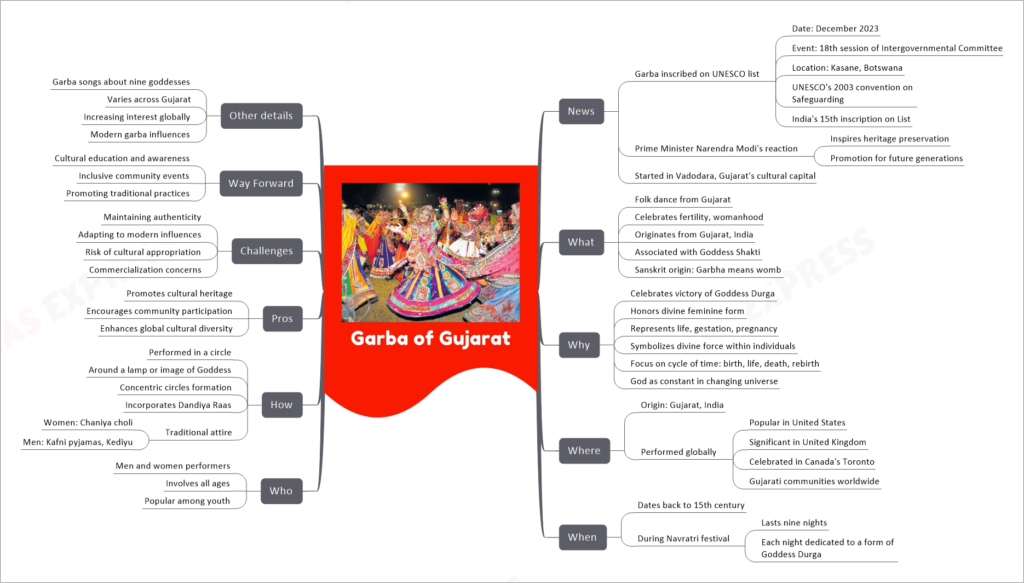Garba of Gujarat: A Celebration of Intangible Cultural Heritage
In a momentous event that unfolded at the 18th session of the Intergovernmental Committee in Kasane, Botswana, in December 2023, Garba, the traditional folk dance of Gujarat, was inscribed on the prestigious UNESCO list. This recognition marks a significant milestone in the realm of cultural preservation and heritage celebration. Prime Minister Narendra Modi’s enthusiastic response to this acknowledgment underscores its importance, not only for the present but also for the future generations. Garba, which had its origins in Vadodara, Gujarat’s cultural capital, has now achieved global recognition and acclaim.
This topic of “Garba of Gujarat: A Celebration of Intangible Cultural Heritage” is important from the perspective of the UPSC IAS Examination, which falls under General Studies Portion.
What is Garba?
Garba is a vibrant and lively folk dance that hails from the state of Gujarat in India. Rooted in the celebration of fertility and womanhood, this dance form is deeply associated with Goddess Shakti, the divine feminine energy. The name “Garba” itself has a Sanskrit origin, with “Garbha” meaning womb. This etymology reflects the dance’s profound connection to the concept of creation and life’s cyclical nature.
Why is Garba Celebrated?
Garba serves as a joyful celebration of the victory of Goddess Durga and honors the divine feminine form. Through its intricate movements and rhythmic patterns, Garba symbolizes various aspects of life, including gestation, pregnancy, and the divine force that resides within individuals. It emphasizes the eternal cycle of time, encompassing birth, life, death, and rebirth, recognizing the constancy of divinity within a changing universe.
Where is Garba Practiced?
Originating in Gujarat, India, Garba has transcended geographical boundaries and is now performed globally. It has gained immense popularity in the United States, holds significant cultural value in the United Kingdom, and is celebrated with great enthusiasm in Toronto, Canada, among Gujarati communities worldwide.
When is Garba Performed?
Garba traces its roots back to the 15th century and is an integral part of the Navratri festival. This festival spans nine nights, with each night dedicated to a specific form of Goddess Durga. The dance performances during Navratri are a tribute to the divine and are filled with spiritual fervor.
Who Participates in Garba?
Garba is an inclusive art form that welcomes performers of all ages, from the young to the elderly. It is a dance that unites men and women in a jubilant celebration of culture and tradition. Its popularity among the youth ensures that this rich heritage continues to thrive.
How is Garba Performed?
The dance is typically performed in a circular formation, with participants dancing around a lamp or an image of Goddess Shakti. The concentric circles created by the dancers symbolize unity and harmony. Garba often incorporates the energetic Dandiya Raas dance and features traditional attire, with women wearing Chaniya choli and men donning Kafni pyjamas and Kediyu.
Pros, Cons, and Challenges
While Garba promotes cultural heritage and encourages community participation, it also faces challenges. There is a risk of cultural appropriation and concerns about commercialization. Balancing authenticity with modern influences presents a challenge, but it is crucial to preserve the essence of this age-old tradition.
The Way Forward
To ensure the continued preservation and celebration of Garba, cultural education and awareness are vital. Inclusive community events can foster a sense of belonging and pride in this cultural heritage. Promoting traditional practices while embracing modernity can strike a harmonious balance that allows Garba to evolve while staying true to its roots.
Other Notable Details
Garba songs often revolve around the worship of the nine goddesses. The dance varies across different regions of Gujarat, showcasing its diversity and adaptability. As interest in Garba continues to grow globally, it also incorporates modern influences, demonstrating its ability to remain relevant and captivating in the ever-changing cultural landscape.
In conclusion, the recognition of Garba as an Intangible Cultural Heritage by UNESCO is a momentous occasion that celebrates the rich cultural tapestry of Gujarat and India as a whole. This vibrant dance form, with its deep-rooted symbolism and inclusivity, serves as a testament to the enduring power of tradition and the importance of preserving our shared heritage.


